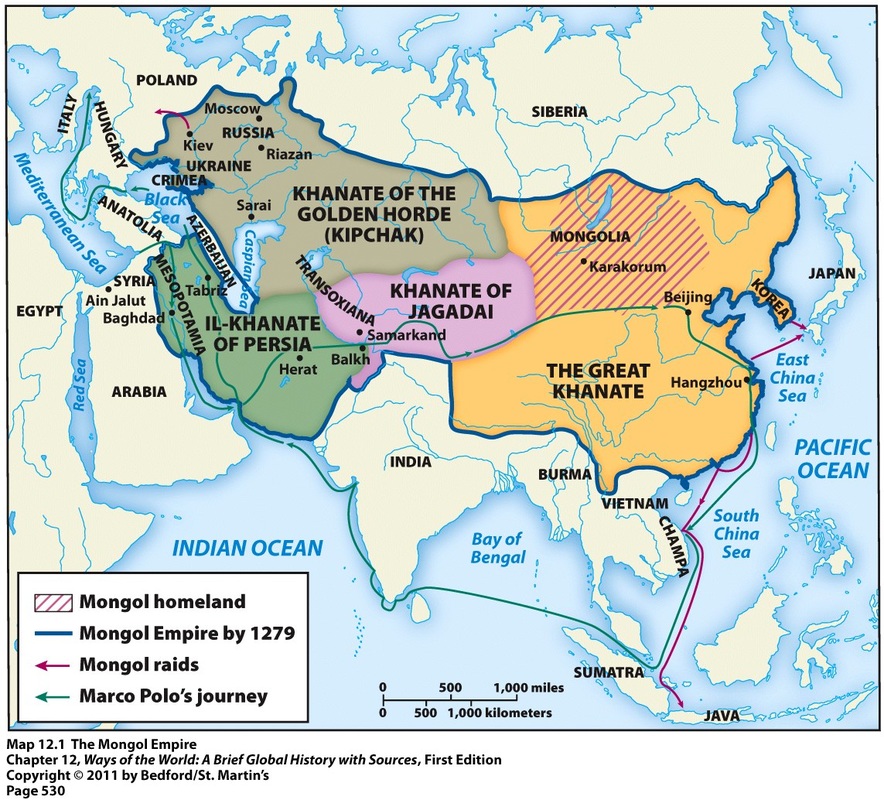The Mongol Empire
3 min read•december 17, 2021
I
Isabela Salman
AP World History: Modern 🌍
577 resourcesSee Units
The Mongol Empire
⚡ Watch: 🎥 AP World History LIVE STREAMS!
During the 1200s, many of the major post-classical empires fell. One central empire grew to be the largest land-based empire in human history -- The Mongols.
The Mongol Empire grew out of a large group of nomads in modern-day Mongolia (go figure) who originally were just small clans. Following the rise of Temujin, later named Genghis Khan, the Mongol Empire grew from, in modern-day terms, South Korea to Poland (they were, and still are, the biggest land-based empire in all of human history).
An empire of this size had to be split up into divisions known as khanates because of their massive size making the empire almost unmanageable as a complete unit.
⚡ Watch: AP World History - 🎥 Unit 2 Review: Networks of Exchange
Khanates
Mongol Khanates:
- Divisions of rule during the Mongol empire, where each state/khanate was ruled by a Khan.

4 Mongol Khanates (after the death of Genghis Khan):
⚔️ Yuan Dynasty (1279–1368)
- China’s first foreign-led dynasty (by the Mongols).
- Led by Kublai Khan.
- Marco Polo served under Kublai for 17 years during his travels to China.
- Chinese locals persecuted and would not be allowed to speak Mongolian.
- Kublai Khan united China after more than 300 years.
- Development of novels and drama during this empire.
- Movable type printing was made more efficient.
- Yuan Dynasty finally plagued with corruption and internal rebellion.
- 1367 Zhu Yuanzhang’s army captured Beijing.
- Ming Dynasty replaced Yuan.
The Yuan Dynasty
Beginnings
- Genghis Khan’s grandson, Kublai Khan, set his sights on China - a more difficult opponent than other previously conquered lands.
- Kublai Khan spent 1235-1271 conquering China. ⚔️
- He assumed the title “Great Khan” in 1260, and 11 years later fully defeated the Chinese.
- Kublai Khan founds the Yuan Dynasty.
Significance
- The Yuan Dynasty was a non-native Chinese ruling force, unlike its predecessor the Song Dynasty and its successor the Ming Dynasty.💥
- Did not try to impose Mongol customs; instead practiced religious tolerance. 🙏🏼
- Increased cultural exchange and expanded trade with other countries - even European ones. 💰📈
- Chinese arts and literature flourished. 📜
- The Yuan Dynasty was part of the Mongol Empire which held control of almost all North, Central, East, and West Asian territories. 🗺
⚔️ Golden Horde (13th to 15th century CE)
- Established in Russia and took over Eastern Europe.
- Later replaced by the Turks.
- Made up of Mongols and Turks.
- Russian princes forced to submit as vassals under Batu Khan.
- Horde began to decline after the invasion of Timur in 1396.
⚔️ Chagatai Khanate (1220s to 17th century)
- Lasted (as a whole) from the 1220s to 17th century.
- Empire split during fragmentation of Mongol empire (after 1259).
- Timur’s empire took control of Western half in 1370.
- Chagatai land was mostly Turkic nomad lands.
⚔️ Ilkhanate (1256-1335 CE)
- Eased trade and commerce across Asia.
- Communication between Ilkhanate and Yuan Dynasty aided trade.
- Rulers of Ilkhanate later converted to Islam.
- The decline began with the death of Ilkan Ghazan in 1304.
What came after The Mongols?
In the Middle East
- ⚡ Watch: AP World History - 🎥 The Islamic Gunpowder Empires
- Following the Mongols, the next major power in the Middle East was the Ottoman Empire
In Russia
- ⚡ Watch: AP World History - 🎥 Expanding Empires in the Early Modern World
- The Kievan Rus were taken over by the Golden Horde and following, the next major power was the Russian Empire
In China
- ⚡ Watch: AP World History - 🎥 China in the Global Middle Ages
- Following the Yuan, the Ming Dynasty rose and maintained the dynastic cycle common throughout Chinese history
Congratulations! You now know about one of the most important empires in human history: the Mongols. You've learned about how they expanded, split up, and who took their place after they fell in the 1300s.
Browse Study Guides By Unit
🐎Unit 1 – The Global Tapestry, 1200-1450
🐫Unit 2 – Networks of Exchange, 1200-1450
🕌Unit 3 – Land-Based Empires, 1450-1750
🍕Unit 4 – Transoceanic Interactions, 1450-1750
✊🏽Unit 5 – Revolutions, 1750-1900
🚂Unit 6 – Consequences of Industrialization, 1750-1900
💣Unit 7 – Global Conflict, 1900-Present
🥶Unit 8 – Cold War & Decolonization, 1900-Present
✈️Unit 9 – Globalization, 1900-Present
✏️Frequently Asked Questions
🚀Thematic Guides
🗺Regional Guides
🤓Historical Thinking Skills
🧐 Multiple Choice Questions (MCQ)
📋Short Answer Questions (SAQ)
📝Long Essay Questions (LEQ)
📑Document Based Questions (DBQ)

Fiveable
Resources
© 2023 Fiveable Inc. All rights reserved.